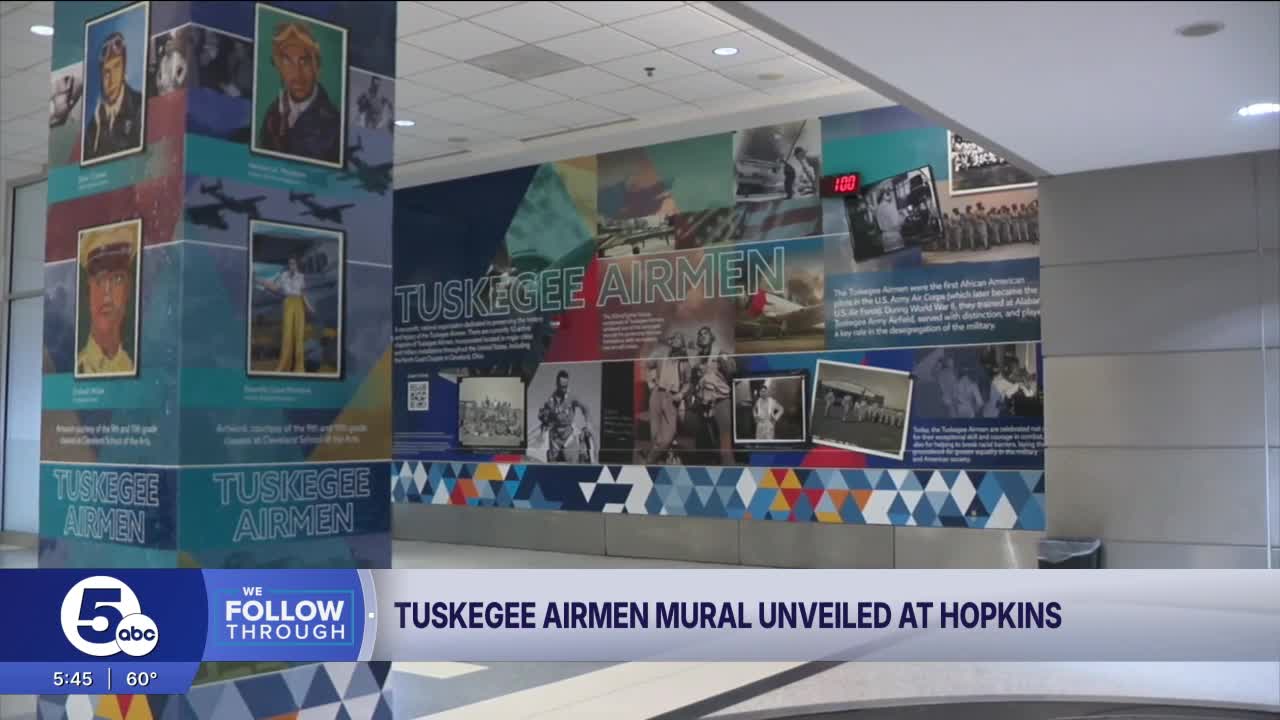CLEVELAND — A mural dedicated to the service and determination of the Tuskegee Airmen, America’s first Black military pilots, was officially unveiled Wednesday at Cleveland Hopkins International Airport.
Nearly 1,000 pilots graduated from the training program in Tuskegee, Alabama, and several dozen pilots hailed from Northeast Ohio.
The tribute isn’t just for those pilots, but also the estimated 14,000 to 19,000 people who were part of the Tuskegee training program, including navigators, crew chiefs, nurses, mechanics, and other support staff.
“It’s a great day for all of the Tuskgee Airmen who are no longer with us,” said Thomas Cargill, with The North Coast Chapter of Tuskegee Airmen Inc. “Their spirit is here. Their spirit is amongst us. They have really kind of paved the way and set an example that we are trying to live up to.”
The local nonprofit’s Cleveland Heroes Project partnered with students from the Cleveland School of the Arts to share the lives and experiences of the service members who transformed both the military and civil rights history.
I first introduced you to the power players in February.
RELATED: CMSD student artists honoring local Tuskegee Airmen
The names, stories, and faces of some of the original Tuskegee Airmen from Northeast Ohio now fill the baggage claim area near carousel number 11.
Cargill said it provides a moment for travelers to pause.
"To realize the contributions that African American men and women have made to this country from its onset,” Cargill said.
The mural includes portraits drawn by the student artists who conducted research on the Tuskegee Airmen before sketching and painting their depictions.
Cargill’s father, 2nd Lt. Gilbert Cargill, is among the portraits on display. Gilbert was born in Oberlin. He trained nearly all of the Tuskegee Airmen pilots who carried out combat missions during World War II, when segregation was legal and many doubted the abilities of African Americans.
“What do you think about that portrait that the student (Karma Carver) did when you look at it?” I asked Thomas.
“I love it. The student showed one—their God-given talent,” Thomas said. “Two, that student got a little bit of my father’s life experience, and as a consequence of that now they’re a historian. They’re really kind of an appendage to my family now.”
Philip Tibbs traveled from Florida to see the mural in person. A handful of photographs that his father, Sgt. Howard Tibbs, took during Tuskegee training, is a part of the project. His father is a Salem native.

“This is a small fraction of the scrapbook and the other memorabilia that he kept,” Philip said.
“How proud are you today of this project?” I asked Philip.
“Very proud. And it’s extremely long overdue,” Philip said.
Philip said his father was a part of the original 99th Fighter Squadron.
He and others commented on how the mural shows the progress the U.S. has made. Tough lessons learned.
“The war in Europe could have ended earlier if segregation in the armed forces was not imposed,” Philip said.
The accomplishments of the Tuskegee Airmen played a pivotal role in the eventual desegregation of the U.S. Armed Forces. Their fight against racism
helped pave the way for President Harry Truman’s 1948 executive order that officially ended segregation in the military.
The Tuskegee Airmen’s achievements helped lead to the desegregation of the U.S. Armed Forces. In 1948, President Harry Truman issued an executive order desegregating the U.S. Armed Forces.
Philip hopes it will spur more people to learn about the heroes.
Lori Lane traveled from Virginia. Her father, Capt. Earl Lane grew up in Wickliffe and flew P-51 Mustangs during the war. His portrait is expected to be added to the mural during Phase 2 of the project.

"I understand the sacrifice he went through and fighting for a country that didn’t fight for him,” Lane said. “That gives me more respect… more honor for everyone and everyone he was with.”
Lane said she just recently learned who her father was. She said her mom, a white woman, hid her father’s identity from her because he was Black and she didn’t want him to be killed.
“So, it wasn’t until I was 50 that I found out through DNA tests that he was my father,” Lane said. “And so, it’s been a wonderful exploration and I’m learning through history and everyone who knew him.”
I also met again with student Khloe Brand.
“All these airmen were very determined and it’s important to acknowledge their history,” Brand said.
Her portrait of Capt. Erwin Lawrence Jr., who served in combat missions in North Africa and Italy, is a part of the collection.
"I’m glad that people can see it and be willing to learn about the Tuskegee Airmen,” Brand said.
Representatives from the airport and the City of Cleveland Department of Port Control were on hand. Students received certificates for their involvement with the project.
Cargill said seeing everyone’s work come together in such a powerful way was humbling.
"It’s just great. This is such a privilege,” Cargill said.
To learn more about the mural, visit The North Coast Chapter of Tuskegee Airmen Inc. online.





